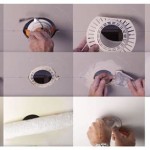How To Replace Ceiling Fan Wall Switch: An Essential Guide
Ceiling fans are an essential comfort amenity, providing cooling and air circulation in homes and offices. However, if the wall switch controlling your ceiling fan malfunctions, it can be a frustrating inconvenience. Replacing a ceiling fan wall switch is a relatively simple task that can be completed in a few steps, even if you have limited electrical experience.
In this comprehensive guide, we will walk you through the essential aspects of replacing a ceiling fan wall switch, including:
- Identifying the correct type of switch
- Safety precautions
- Step-by-step instructions
- Troubleshooting tips
Identifying the Correct Type of Switch
The first step in replacing a ceiling fan wall switch is to determine the correct type of replacement switch. This involves identifying the voltage, amperage, and switch type.
- Voltage: Most ceiling fans operate on standard 120-volt household electricity.
- Amperage: The amperage rating of the switch should match or exceed the amperage load of your ceiling fan. The amperage rating is usually printed on the ceiling fan motor housing.
- Switch Type: Ceiling fans typically use single-pole switches, which control one circuit. Some fans may require double-pole switches, which control two circuits.
Safety Precautions
Before beginning any electrical work, it is crucial to take safety precautions to minimize the risk of electrical shock:
- Turn off power at the circuit breaker or fuse box: Locate the electrical panel and switch off the circuit supplying power to the ceiling fan.
- Test the power: Use a non-contact voltage tester to ensure that the power is off at the switch location.
- Wear insulated gloves: Protect your hands from electrical hazards by wearing insulated gloves.
Step-by-Step Instructions
Follow these step-by-step instructions to replace your ceiling fan wall switch:
- Remove the switch plate: Use a flathead screwdriver to remove the screws holding the switch plate in place.
- Unscrew the switch: Loosen the screws holding the switch in the electrical box and carefully pull the switch out.
- Disconnect the wires: Note the position and color of the wires connected to the switch. Use a screwdriver to loosen the terminal screws and remove the wires.
- Connect the wires to the new switch: Match the wires to the corresponding terminals on the new switch and tighten the terminal screws securely.
- Push the switch back into the box: Carefully tuck the wires into the electrical box and push the switch back into its seat.
- Screw in the switch: Tighten the screws to secure the switch in place.
- Install the switch plate: Reattach the switch plate using the screws.
- Turn on the power and test: Restore power to the circuit and test the switch to verify it is working properly.
Troubleshooting Tips
If you encounter any issues when replacing your ceiling fan wall switch, try the following troubleshooting tips:
- Check the wire connections: Ensure that all wire connections are secure and there are no loose or frayed wires.
- Inspect the switch: Look for signs of damage, corrosion, or burn marks on the switch.
- Consider the circuit breaker or fuse: If the switch is not working, check if the circuit breaker has tripped or the fuse has blown.
If you are not confident troubleshooting the switch yourself, it is advisable to consult a qualified electrician.
Replacing A Ceiling Fan Light With Regular Fixture Jlc

Wiring A Ceiling Fan And Light With Diagrams Ptr

Replacing A Ceiling Fan Light With Regular Fixture Jlc

How To Install A Ceiling Fan Two Wall Switches What Bb Built
How To Wire A Ceiling Fan Light Switch Quora

How To Wire A Ceiling Fan Control Using Dimmer Switch

How Do I Install New Hunter Ceiling Fan With Remote Control And Still Have Switch Wall For The Light Separately R Homemaintenance

Recommendations To Replace These Fan Light Combo Switches R Homeautomation

Enerlites 2 5 Amp 3 Sd Ceiling Fan Control And Led Dimmer Light Switch In White With Wall Plates Pack 17001 F3 Wwp3p The Home Depot

Ceiling Fan W Cfl And Dimmer Switch Doityourself Com Community Forums
Related Posts








